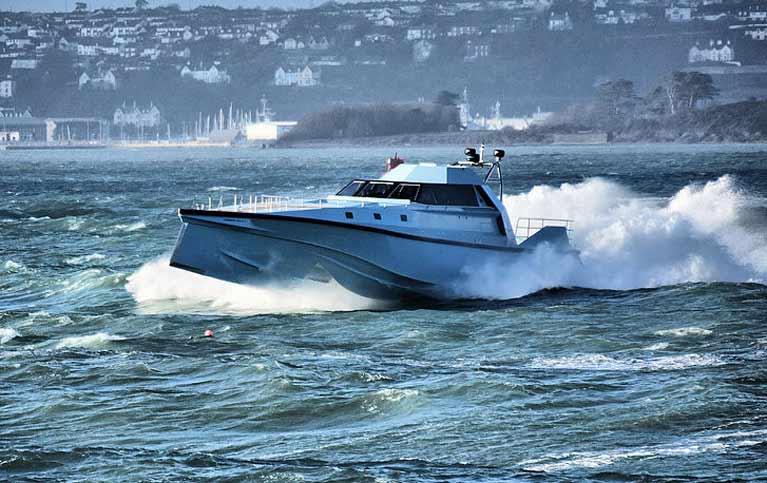There was something about the look of the reverse stem of Safehaven Marine’s new 70ft Transatlantic record-seeker Thunder Child II in Afloat.ie this week which stirred a hidden memory of ships and speed writes W M Nixon. And then it clicked. Suddenly, we were transported back to the heady days of the 1890s, a Golden Age of engine invention. The memory was of Charles A Parsons of Birr, and his new steam turbine powered speedster Turbinia.
But apart from both having a reverse stem, the only other shared features of Turbinia and Thunder Child II are their quest for speed, and their links to Ireland. Thunder Child’s shape is a fascinating, inventive and exhaustively tank-tested mixture of mono-hull and catamaran, while Turbinia by contrast is a hundred feet of miniature naval destroyer, long and skinny with quite heavy displacement.
 Thunder Child II – “a fascinating, inventive and exhaustively tank-tested mixture of mono-hull and catamaran” Photo Safehaven Marine
Thunder Child II – “a fascinating, inventive and exhaustively tank-tested mixture of mono-hull and catamaran” Photo Safehaven Marine
Her creator was Charles A Parsons (1854-1931). The Parsons of Birr Castle were a very inventive and engineering-minded family, as anyone who has seen the mighty telescope at the castle will know. So although young Charles was educated at home, his tutors included some noted engineers, and after he’d dutifully done his time at Trinity College Dublin, he took the unusual step – for someone from his background - of signing up as an apprentice in what was then the engineering invention hotbed of the northeast of Englan
 The commercial breakthrough – the tiny Turbinia alongside the new ocean liner Mauretania in 1906. Although the Royal Navy had started to use steam turbine power soon after Turbinia’s dramatic debut at the Fleet Review of 1897, it took a few years before Mauretania appeared as the first steam turbine-powered commercial vessel.
The commercial breakthrough – the tiny Turbinia alongside the new ocean liner Mauretania in 1906. Although the Royal Navy had started to use steam turbine power soon after Turbinia’s dramatic debut at the Fleet Review of 1897, it took a few years before Mauretania appeared as the first steam turbine-powered commercial vessel.
In due course in 1889, he and five partners established C A Parsons & Co to develop and demonstrate his invention of the compound steam turbine. From this emerged the Parsons Marine Steam Turbine Company in Newcastle, which commissioned the building of the Turbinia in 1894. It took several experiments with propeller designs and configurations before they felt they were getting the best out of the little ship, but it was time well spent, for in 1897 the Diamond Jubilee of Queen Victoria saw the cream of the Royal Navy (a huge fleet in those days) assembled off Spithead for a formal review. The Turbinia – uninvited - came up and down through their serried ranks at a speed of 34 knots, much faster than any other ship of the time. The future of steam turbine marine power was assured.
These days, you can see the restored hull of the Turbinia in the Discovery Museum in Newcastle-on-Tyne, while her engine is in the Science Museum in London. As to where Thunder Child II will be in 125 years’ time – well, that’s anyone’s guess.
 Turbinia’s hull on display in the Discovery Museum in Newcastle-on-Tyne
Turbinia’s hull on display in the Discovery Museum in Newcastle-on-Tyne


























































